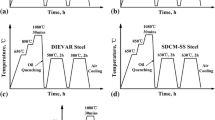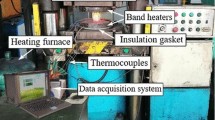Abstract
During the hot press forming process, the die experiences repeated thermal and mechanical loads owing to exposure to the heated workpiece. Such repeated thermal loads may cause deterioration in the mechanical properties of the die, leading to fatigue failure. Therefore, for the successful implementation of the hot press forming process in mass production, it is necessary to estimate the die life under hot press forming conditions. The fatigue life of a hot press forming die is estimated based on the stress history of the die during the forming process. Because accurate understanding of thermal behavior is essential for reliable analysis of fatigue life of the die at elevated temperatures, we characterized the thermal boundary condition, i.e., the heat transfer coefficient at the die-workpiece interface. For this purpose, die temperatures during a hot press forming process were measured as a function of time at select locations on the die. Inverse finite element method (FEM) analysis of the hot press forming process was performed to determine the interface heat transfer coefficient. The interface heat transfer coefficient was applied to the FEM simulation, and the temperature distribution and stress values for the die were determined. Considering the thermomechanical stress history, the fatigue life of the die was estimated based on the stress-life approach.
Similar content being viewed by others
References
Altan, T. (2006). Hot-stamping boron-alloyed steels for automotive parts, part I: Process methods and uses. Stamping J., 4041.
Budynas, R. and Nisbett, K. (2010). Shigley’s Mechanical Engineering Design. 9th edn. McGrawHill. New York.
Concer, D., Woellner, N. and Marcondes, P. V. P. (2012). Approach to the prediction of thermal fatigue of aluminium high pressure die casting (AISI H13) using the Basquin equation and finite elements. J. Achievements in Materials and Manufacturing Engineering 55, 2, 439–445.
Gronostajski, Z., Hawryluk, M., Krawczyk, J. and Marciniak, M. (2013). Numerical modelling of the thermal fatigue of steel WCLV used for hot forging dies. Maintenance and Reliability, 129–133.
Kang, G. and Lee, K. (2008). FE analysis of hot press forming process considering the phase transformation. Proc. 2008 Fall Conf. KSTP, 226–229.
Kim, E. H., Kim, H. K., Seo, K. S., Lee, M. K. and Cho, C. D. (2011). Performance evaluation of a thermo siphon type radiator for LED lighting system by using an inverse heat transfer method. Trans. Mater. Process 20, 7, 473–478.
Kim, H. K. and Oh, S. I. (2001). Evaluation of heat transfer coefficient during heat treatment by inverse analysis. J. Materials Processing Technology, 112, 157–165.
Kim, N. H. and Kang, C. G. (2010). The prediction of interfacial heat transfer coefficient according to contact time and pressure in forging and casting die materials for the hot press forming. Trans. Mater. Process 19, 6, 378–386.
Koistinen, D. P. and Marburger, R. E. (1959). A general equation prescribing the extent of the austenite-martensite transformation in pure iron-carbon alloys and plain carbon steels. Acta Metall 7, 1, 59–60.
Lee, M.-G., Kim, S.-J., Han, H. N. and Jeong, W. C. (2009). Application of hot press forming process to manufacture an automotive part and its finite element analysis considering phase transformation plasticity. Int. J. Mech. Sci., 51, 1112, 888–898.
Lee, S-Y., Lee, K., Lim, Y. H. and Jeong, W. C. (2012). Evaluation for the cooling capability of hot press forming die. KSAE Annual Conf. Proc., Korean Society Automotive Engineers, 2104–2108.
Lenhard, A. L., Damasio, S. F., Milke, A. R. and Schaeffer, L. (2006). Method to estimate workpiece-die heat transfer coefficient on precision warm forging process. Proc. 4th JSTP Int. Seminar on Precision Forging, 93–98.
Park, J. K., Kim, Y. S., Seo, O. S., Lee, M. G. and Kim, H. Y. (2013). Improved hot-stamping analysis of tublular boron steel with direct measurement of heat convection coefficient. Int. J. Automotive Technology 14, 5, 717–722.
Seo, O. S., Kim, K. J., Kim, H. Y., Park, J. K. and Suh, C. H. (2010). Hot press forming analysis of boron steel tube by applying measured heat transfer coefficients. KSAE Annual Conf. Proc., Korean Society Automotive Engineers, 989–994.
Shibusawa, T., Kobayashi, Y. and Ishikawa, K. (1997). Fatigue crack propagation in die-castAZ 91D magnesium alloy. Nippon Kinzoku Gakaishi. J. Japan Institute of Metals 61, 4, 298–302.
Song, Y. C., Yoh, E. G. and Lee, Y. S. (1999). A study on the prediction of fatigue life in die. J. Korean Society of Machine Tool Engineers 8, 4, 87–92.
Yoh, E. G., Lee, T. M. and Lee, Y. S. (2002). A study on the high temperature fatigue behavior of hot forging die STD61 steel. Proc. KSPE 2002 Spring Conf., 711–714.
Author information
Authors and Affiliations
Corresponding author
Rights and permissions
About this article
Cite this article
Kim, D.Y., Kim, H.Y., Lee, S.H. et al. Life estimation of hot press forming die by using interface heat transfer coefficient obtained from inverse analysis. Int.J Automot. Technol. 16, 285–292 (2015). https://doi.org/10.1007/s12239-015-0030-5
Received:
Revised:
Accepted:
Published:
Issue Date:
DOI: https://doi.org/10.1007/s12239-015-0030-5




